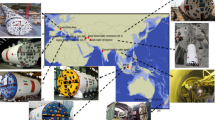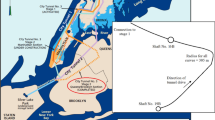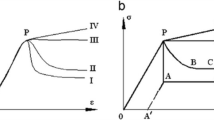Abstract
In recent years, anumber of models and formulas have been proposed to estimate the penetration rate of hard rock tunnel boring machines (TBMs). This study will focus on sensitivity analysis and examination of the effects of variation in the input parameters on the results of the commonly used performance prediction models for rock TBMs. The results of modeling were compared with the recorded machine performance to evaluate the validity and accuracy of these models. The sensitivity analysis of the four most common models indicates that uniaxial compressive strength followed by rock mass fracturing is among the most influential parameters used in these models. In addition, the result of our analysis shows that increasing the number of independent input variables does not increase the accuracy of prediction. The effect of discontinuity orientation in some models has also been considered. The results indicate that substantial changes in the angle between the discontinuity orientation and the tunnel axis have minor effects on penetration rate. The results of models were compared to recorded TBM penetration rate during excavation of Golab Tunnel, and the results indicate that the Gong model has the lowest error in comparison with other models. Grouping the rock types and using pertinent equations in the Farrokh model offered overall higher accuracy than other models in some structures of the Golab project. A brief set of recommendations are offered about the models and their applicability to various ground conditions.








Similar content being viewed by others
References
Aeberli U, Wanner W (1978) On the influence of discontinuities at the application of tunneling machines. In: Proceedings of the 3rd international congress IAEG, Madrid
Alber M (1996) Prediction of penetration and utilization for hard rock TBMs. In: Proceedings of the International Conference of Eurock
Barton N (1999) TBM performance estimation in rock using QTBM. Tunn Tunn Int 31(9):41–48
Bieniawski Z, Grandori R (2007) Predicting TBM Excavability-Part II. Tunn Tunn Int
Bieniawski Z, Tamames B, Fernandez J, Hernandez M (2006) Rock mass excavability (RME) indicator: new way to selecting the optimum tunnel construction method. International Congress ITA, Seul (Korea)
Bieniawski Z, Celada B, Galera J (2007) TBM excavability: prediction and machine-rock interaction. RETC, Toronto, pp 1118
Cassinelli FS Cina, Innaurato N (1983) Power consumption and metal wear in tunnel-boring machines: analysis of tunnel-boring operation in hard rock: In: Tunneling 82, Proceedings of the 3rd International Symposium, Brighton, 7–11 June 1982, P73–81. Publ London: IMM, 1982. International Journal of Rock Mechanics and Mining Sciences & Geomechanics Abstracts, Pergamon
Delisio A, Zhao J, Einstein H (2013) Analysis and prediction of TBM performance in blocky rock conditions at the Lötschberg Base Tunnel. Tunn Undergr Space Technol 33:131–142
Farmer I, Glossop N (1980) Mechanics of disc cutter penetration. Tunn Tunn 12(6):22–25
Farrokh E, Rostami J, Laughton C (2012) Study of various models for estimation of penetration rate of hard rock TBMs. Tunn Undergr Space Technol 30:110–123
Ghasemi E, Yagiz S, Ataei M (2014) Predicting penetration rate of hard rock tunnel boring machine using fuzzy logic. Bull Eng Geol Environ 73(1):23–35
Gong Q, Zhao J (2009) Development of a rock mass characteristics model for TBM penetration rate prediction. Int J Rock Mech Min Sci 46(1):8–18
Gong Q, Zhao J, Jiang Y (2007) In situ TBM penetration tests and rock mass boreability analysis in hard rock tunnels. Tunn Undergr Space Technol 22(3):303–316
Hamilton W, Dollinger G (1979) Optimizing tunnel boring machine and cutter design for greater boreability. RETC Proc Atlanta 1:280–296
Hassanpour J, Rostami J, Khamehchiyan M, Bruland A (2009) Developing new equations for TBM performance prediction in carbonate-argillaceous rocks: a case history of Nowsood water conveyance tunnel. Geomech Geoengin Int J 4(4):287–297
Hassanpour J, Rostami J, Khamehchiyan M, Bruland A, Tavakoli H (2010) TBM performance analysis in pyroclastic rocks: a case history of Karaj water conveyance tunnel. Rock Mech Rock Eng 43(4):427–445
Hassanpour J, Rostami J, Zhao J (2011) A new hard rock TBM performance prediction model for project planning. Tunn Undergr Space Technol 26(5):595–603
Imensazan Consulting Co. (2006) Engineering Gelogical report of Golab Tunnel
Innaurato N, Mancini A, Rondena E, Zaninetti A (1991) Forecasting and effective TBM performances in a rapid excavation of a tunnel in Italy. 7th ISRM Congress
Kahraman S (2002) Correlation of TBM and drilling machine performances with rock brittleness. Eng Geol 65(4):269–283
Khademi Hamidi J, Shahriar K, Rezai B, Rostami J (2010) Performance prediction of hard rock TBM using Rock Mass Rating (RMR) system. Tunn Undergr Space Technol 25(4):333–345
Nelson P, Ingraffea A, O’Rourke T (1985) TBM performance prediction using rock fracture parameters. Int J Rock Mech Min Sci Geomech Abstr, Elsevier
Ozdemir L, Wang F-D (1979) Mechanical tunnel boring prediction and machine design. NASA STI/Recon Tech Rep N 80:16239
Ramamurthy T (2008) Penetration rate of TBMs. World Tunnel Congress
Ribacchi R, Fazio AL (2005) Influence of rock mass parameters on the performance of a TBM in a gneissic formation (Varzo Tunnel). Rock Mech Rock Eng 38(2):105–127
Rostami J (1997) Development of a force estimation model for rock fragmentation with disc cutters through theoretical modeling and physical measurement of crushed zone pressure, Colorado School of Mines
Rostami J (2016) Performance prediction of hard rock Tunnel Boring Machines (TBMs) in difficult ground. Tunn Undergr Space Technol 57:173–182
Rostami J, Ozdemir L (1993) A new model for performance prediction of hard rock TBMs. In: Proceedings of the Rapid Excavation and Tunneling Conference, SOCIETY FOR MINING, METALLOGY & EXPLORATION, INC
Rostami J, Ozdemir L, Nilson B (1996) Comparison between CSM and NTH hard rock TBM performance prediction models. In: Proceedings of Institute of Shaft Drilling Technology (ISDT) annual technical conference
Roxborough FF, Phillips HR (1975) Rock excavation by disc cutter. Int J Rock Mech Min Sci Geomech Abstr, Elsevier
Sanio H (1985) Prediction of the performance of disc cutters in anisotropic rock. Int J Rock Mech Min Sci Geomech Abstr, Elsevier
Sapigni M, Berti M, Bethaz E, Busillo A, Cardone G (2002) TBM performance estimation using rock mass classifications. Int J Rock Mech Min Sci 39(6):771–788
Sato K, Gong F, Itakura K (1991). Prediction of disc cutter performance using a circular rock cutting ring. In: Proceedings 1st international mine mechanization and automation symposium
Shaterpour A, Tumac D, Avunduk E (2016) Double shield TBM performance analysis in difficult ground conditions: a case study in the Gerede water tunnel, Turkey. Bull Eng Geol Environ 75(1):251–262
Snowdon R, Ryley M, Temporal J (1982) A study of disc cutting in selected British rocks. Int J Rock Mech Min Sci Geomech Abstr, Elsevier
Sundaram N, Rafek A, Komoo I (1998). The influence of rock mass properties in the assessment of TBM performance. In: Proceedings of the Eighth IAEG Congress, Vancouver, Balkema
Sundin N-O, Wanstedt S (1994) A boreability model for TBM’s. rock mechanics models and measurements challenges from industry. In: Proceedings of the 1st North American Rock Mechanics Symposium, The University of Texas at Austin, Balkema, Rotterdam
Yagiz S (2008) Utilizing rock mass properties for predicting TBM performance in hard rock condition. Tunn Undergr Space Technol 23(3):326–339
Yasar S, Capik M, Yilmaz AO (2015) Cuttability assessment using the drilling rate index (DRI). Bull Eng Geol Environ 74(4):1349–1361
Author information
Authors and Affiliations
Corresponding author
Rights and permissions
About this article
Cite this article
Fatemi, S.A., Ahmadi, M. & Rostami, J. Evaluation of TBM performance prediction models and sensitivity analysis of input parameters. Bull Eng Geol Environ 77, 501–513 (2018). https://doi.org/10.1007/s10064-016-0967-2
Received:
Accepted:
Published:
Issue Date:
DOI: https://doi.org/10.1007/s10064-016-0967-2




